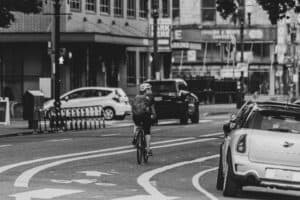7 ways for bike commuters to stay safe
Approximately 872,000 people commute to work by bicycle, according to the most recent data from the American Community Survey. Washington, D.C., and Portland, Oregon, rank among the country’s top cities for bike commuters. Whether you’ve been commuting to work by bicycle for years or you’re planning to start now, it’s important to protect yourself while you’re on the road. Explore the following seven ways you can stay safe on your bike while commuting to work.
Learn Your Route

If you’re new to commuting by bike, take the time to learn your route. Familiarize yourself with the bike lanes on your city’s streets. When you’re planning your route to work, you should also make time for a test ride. Find out which side streets you can take to avoid road construction closures or heavy traffic.
Various apps, such as Bike Hub and Strava, can help you plan and track your route. The more familiar you become with your route, the less nervous and the more confident you’ll feel during your commute.
Wear a Helmet

You may be tempted to forego wearing a helmet while on your bike so that you can maintain your hairstyle before you get to work. However, a helmet is perhaps the most important piece of biking equipment you can own, and it’s something you should always wear regardless of the length of your commute.
The National Safety Council cites the following statistic from the Consumer Product Safety Commission: A majority of the 80,000 cycling-related head injuries treated in emergency rooms each year are brain injuries. Additionally, a bike helmet is a cyclist’s best measure of defense, reducing the risk of head injury by more than 50%.
A properly fitting bike helmet could indeed save your life if you’re involved in a biking accident.
Make Sure Others Can See You
Cyclists need to keep visibility at the top of their mind when they’re on their bikes. This point is especially true for cyclist commuters. Before you mount your bicycle and take to the road, make sure that you and your bike are equipped with the following:
- Headlights: Use a bright, front-facing highlight to light your path and create visibility from the front of the bike. When selecting a headlight for your bike, look for one with long-lasting batteries, easy installation, and a strong light output. Headlights with flashing features will help to conserve battery life and draw attention to you while you’re on your bike.
- Taillights: Just as you need to be visible from the front of your bike, you also want to be visible from the back. As with headlights, you want taillights that are bright, easy to install, and have long-lasting batteries. Some bicycle helmets offer mountable rear-facing taillights for safety and visibility.
- High-visibility accessories and clothing: High-visibility (or hi-vis) accessories and clothing can help you stand out in all lighting conditions and all times of the day. Hi-vis clothing is generally available in colors such as neon green, orange, and yellow.
Ride Defensively and Use Body Language To Signal Your Intentions
Hand signals offer a means of communication with other drivers who share the road with you. For example, when you’re planning to change lanes or turn, signal with your body and your hands. Over-communicate your movements so that other drivers are aware of you, your place on the road, and your intentions.
Ride defensively while on the road. Remember, you are just like any other vehicle. Stay at least one bike’s length away from other vehicles for every 5 miles per hour you’re going. You should also leave extra space between your bike and stopped vehicles.
Pass Behind Pedestrians

When you encounter pedestrians on your path, assume that they will behave unpredictably, such as by making unexpected moves or stopping in their tracks. As such, if you need to make your way around pedestrians, always pass behind them, not in front of them. In general, pedestrians will usually move forward rather than backward to get out of harm’s way.
Watch for Opening Vehicle Doors
Opening vehicle doors are perhaps one of the most ever-present hazards bicyclists face on the road, particularly on city streets. When a driver opens a door directly into the space that bikes occupy, this sudden action can often startle or catch bicyclists off guard, which could lead to an accident. To avoid being taken by surprise when you encounter an open vehicle door, assume that every door you encounter will open on you.
Here’s a good rule to follow: Leave a door-sized space between you and every stopped vehicle, not just ones that are parked. If you have to squeeze into the door-clearance zone, look for signs that a door may be about to open, such as brake lights activating, passengers shifting in their seats inside the vehicle, and taxi vacancy lights.
Keep Your Eyes on the Road
While cycling, pay attention to road hazards you may encounter during your commute. Be careful of road surfaces that may become slick when wet. Watch for metal drain and sewer covers, steel plates from road construction, tree limbs and piles of leaves, and other debris. If you require eyeglasses to perform your daily activities, be sure to wear them or a pair of prescription sunglasses so that you can see clearly while you’re cycling.
You should also avoid wearing headphones or earbuds while in motion. These devices can distract you from paying attention to road conditions and the environment around you.
Each time you climb aboard your bike, it’s vital to maintain your personal safety. Unfortunately, just as with motor vehicles, bicycle accidents can happen. If you or a loved one has been injured due to a bicycle accident resulting from another party’s negligence, you have legal rights. The attorneys at Lem Garcia Law are committed to helping you and your loved ones receive the legal support you need. Our team is proud to serve West Covina and the surrounding communities.
Fill out our contact form or call us at 626-337-1111 or text 626-252-2168 to schedule a free consultation. We’ll help you fight for your rights and receive the compensation you deserve.


